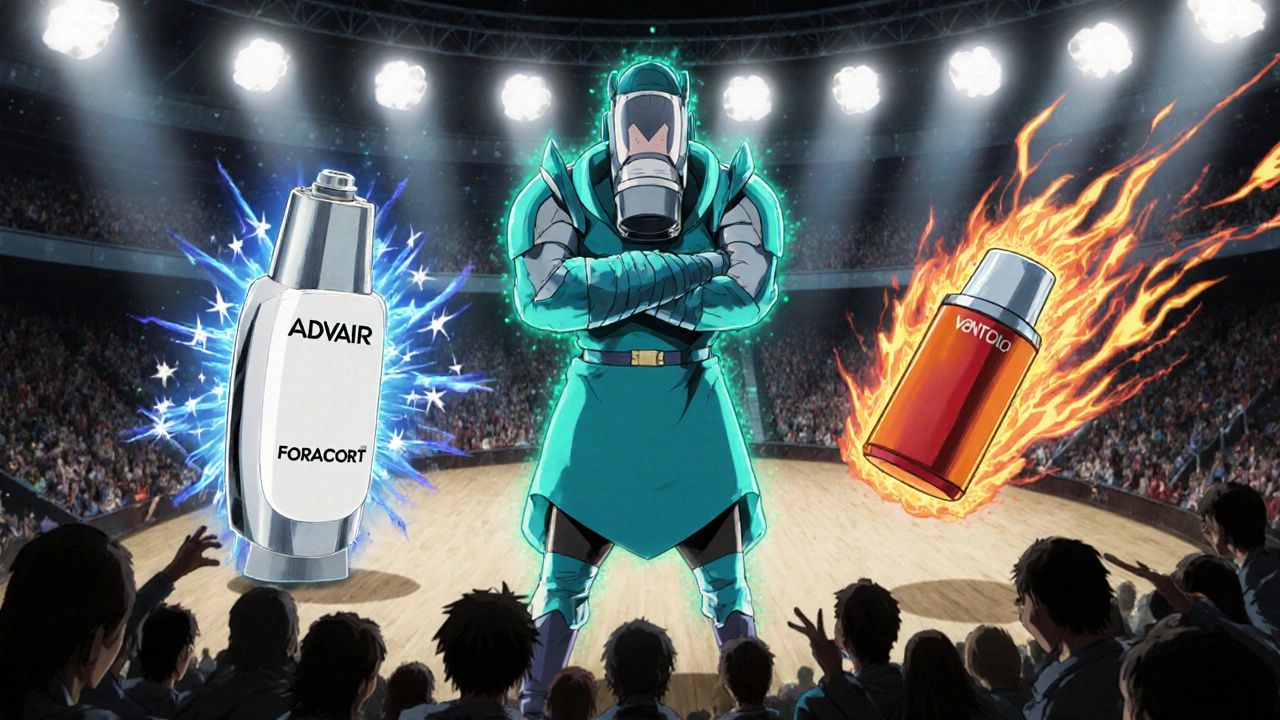Asthma Inhaler Decision Guide
This tool will help you determine which asthma inhaler might be best for your specific situation based on your needs and preferences.
Question 1: Do you need a single device that covers both maintenance and rescue?
Question 2: Do you prefer a dry-powder inhaler over a metered-dose?
Question 3: Is cost a major factor?
Question 4: How important is once-daily dosing?
Recommended Inhaler:
Why this is the best choice for you:
Cost comparison:
When treating moderate asthma, Foracort Inhaler is a fixed‑dose combination of the long‑acting β2‑agonist Formoterol and the inhaled corticosteroid Budesonide. This combo aims to open airways while reducing inflammation, letting patients breathe easier for up to 12 hours per puff. If you’ve ever wondered whether there’s a cheaper, more convenient, or faster‑acting option, you’re not alone. Below is the low‑down on how Foracort stacks up against the most common alternatives on the market today.
Key Takeaways
- Foracort delivers both a bronchodilator (Formoterol) and a corticosteroid (Budesonide) in one device, simplifying daily routines.
- Alternatives like Symbicort, Advair, and Breo Ellipta offer similar dual‑therapy but differ in dosing frequency, cost, and onset speed.
- Pure‑reliever inhalers such as Ventolin (Albuterol) act faster but lack anti‑inflammatory benefits.
- Choosing the right inhaler depends on your asthma severity, lifestyle, insurance coverage, and personal preference for inhaler type (MDI vs. DPI).
How Foracort Works
Formoterol is a long‑acting β2‑adrenergic agonist (LABA) that relaxes smooth muscle in the airways, providing bronchodilation for up to 12 hours. Meanwhile, Budesonide is an inhaled corticosteroid (ICS) that suppresses airway inflammation, reducing the frequency of asthma attacks. Together, they tackle two core asthma problems: constricted airways and chronic inflammation. The inhaler uses a press‑urized metered‑dose (MDI) system, delivering a consistent spray with each actuation.
Clinical trials published in 2022 showed that patients using Formoterol‑Budesonide combos experienced a 30 % reduction in exacerbations compared with using an ICS alone. The rapid onset of Formoterol (within minutes) also means it can double as a reliever in “SMART” (Single Maintenance And Reliever Therapy) regimens, although patients should follow their physician’s instructions.
Top Alternatives to Foracort
Below are the most widely prescribed inhalers that either match the dual‑therapy approach or serve as pure relievers. Each entry includes a brief description, typical dosing, and who might benefit most.
- Symbicort is a combination of Formoterol and Budesonide, available in both metered‑dose and dry‑powder formats. It’s popular for its flexible dosing-twice‑daily or as needed under a SMART plan.
- Advair is a fixed‑dose combo of Fluticasone propionate (ICS) and Salmeterol (LABA) delivered via a dry‑powder inhaler (DPI). Often chosen for patients who prefer DPI over MDI.
- Pulmicort is an inhaled corticosteroid (Budesonide) used alone for mild‑to‑moderate asthma. It lacks a LABA, so it’s not a reliever‑ready option.
- Ventolin is a short‑acting β2‑agonist (Albuterol) that provides rapid bronchodilation within minutes. Ideal for rescue use but does not address inflammation.
- Breo Ellipta is a once‑daily combination of Fluticasone furoate (ICS) and Vilanterol (LABA) in a dry‑powder device. Good for patients who want a single‑dose‑a‑day regimen.

Side‑by‑Side Comparison
| Inhaler | Drug Combo | Indications | Dose Frequency | Onset (min) | Typical US$ Cost per Month | FDA Approval Year |
|---|---|---|---|---|---|---|
| Foracort | Formoterol + Budesonide | Asthma, COPD | 2 puffs bid | 5‑10 | $55‑$70 | 2020 |
| Symbicort | Formoterol + Budesonide | Asthma, COPD | 2 puffs bid (or 1‑2 puffs qd for SMART) | 5‑10 | $60‑$80 | 2006 |
| Advair | Fluticasone + Salmeterol | Asthma, COPD | 1 inhalation bid | 10‑15 | $70‑$90 | 2000 |
| Pulmicort | Budesonide (ICS) | Mild‑moderate asthma | 1‑2 puffs bid | 5‑10 | $40‑$55 | 1998 |
| Ventolin | Albuterol (SABA) | Acute bronchospasm | 1‑2 puffs PRN | 1‑3 | $20‑$30 | 1995 |
| Breo Ellipta | Fluticasone furoate + Vilanterol | Asthma, COPD | 1 inhalation qd | 15‑20 | $80‑$100 | 2015 |
Pros and Cons of Each Option
- Foracort
- Pros: Combines fast‑acting LABA with anti‑inflammatory ICS in a single MDI; quick onset; flexible SMART dosing.
- Cons: Requires coordination for inhaler actuation and breathing; slightly higher out‑of‑pocket cost than Budesonide‑only inhalers.
- Symbicort
- Pros: Same drug combo as Foracort but offers both MDI and DPI formats; widely covered by insurance.
- Cons: Slightly more expensive; some patients find the DPI device harder to load.
- Advair
- Pros: Popular brand with extensive real‑world data; DPI eliminates need for propellant.
- Cons: Onset is slower (10‑15 min); Salmeterol cannot be used as a reliever under SMART guidelines.
- Pulmicort
- Pros: Lower cost; ideal for patients who only need an anti‑inflammatory component.
- Cons: No bronchodilator, so a separate SABA is required for acute symptoms.
- Ventolin
- Pros: Fastest onset; inexpensive; easy to use.
- Cons: No anti‑inflammatory effect; overuse can increase tolerance and side‑effects.
- Breo Ellipta
- Pros: Once‑daily dosing improves adherence; high potency ICS.
- Cons: Higher price; slower onset; DPI may be difficult for very young children.

Decision Guide: Which Inhaler Fits Your Lifestyle?
Answer these quick questions to narrow down the best choice.
- Do you need a single device that covers both maintenance and rescue?
Yes → Foracort or Symbicort (SMART‑compatible). No → Consider separate ICS and SABA. - Do you prefer a dry‑powder inhaler over a metered‑dose?
Yes → Advair, Breo Ellipta, or Symbicort DPI. No → Foracort MDI or Ventolin MDI. - Is cost a major factor?
Yes → Pulmicort + Ventolin combo is usually the cheapest. No → Premium options like Breo Ellipta may offer convenience. - How important is once‑daily dosing?
Yes → Breo Ellipta. No → Twice‑daily options (Foracort, Symbicort, Advair) work fine.
Talk to your pulmonologist or primary‑care doctor about these factors. Insurance formularies often dictate which brand is easiest to get, so bring your pharmacy benefits information to the appointment.
Potential Pitfalls & How to Avoid Them
- Improper inhaler technique: A poorly coordinated MDI puff can deliver only a fraction of the dose. Use a spacer or practice with a placebo device.
- Confusing rescue with maintenance: Never replace a prescribed LABA/ICS combo with a SABA for daily control. Keep a rescue inhaler on hand for sudden flare‑ups.
- Overusing LABA: Excessive Formoterol or Salmeterol without adequate steroid coverage can increase the risk of asthma‑related deaths. Always follow the prescribed schedule.
- Ignoring expiration dates: Potency drops after the printed date, especially for MDIs that rely on propellants.
Frequently Asked Questions
Can I use Foracort as a rescue inhaler?
Yes, when prescribed under a SMART (Single Maintenance And Reliever Therapy) plan. The Formoterol component works within minutes, but you should still have a quick‑acting SABA like Ventolin for severe attacks.
Is there a generic version of Foracort?
As of 2025, the FDA has not approved a generic formulation that combines Formoterol and Budesonide in a single MDI. You can obtain separate generic Budesonide inhalers and a Formoterol MDI, but the dosing convenience differs.
What’s the difference between Formoterol and Salmeterol?
Both are LABAs, but Formoterol has a faster onset (5‑10 min) and can be used as a reliever, whereas Salmeterol takes 10‑15 min and is only approved for maintenance.
Can children use Foracort?
The inhaler is approved for patients aged 12 years and older. For younger kids, doctors often prescribe a separate pediatric‑dose Budesonide inhaler plus a SABA.
How does insurance coverage compare across these inhalers?
Coverage varies by plan. Tier‑1 drugs like generic Albuterol are almost always covered. Brand‑name combos (Foracort, Symbicort, Advair) may sit in Tier‑2 or Tier‑3, requiring higher co‑pays. Always check your pharmacy benefits manager for exact tiers.
Choosing the right inhaler isn’t a one‑size‑fits‑all decision. By weighing onset speed, dosing frequency, cost, and device preference, you can land on a solution that keeps your lungs clear and your wallet happy. Remember, the most effective inhaler is the one you use correctly every day.






Ekeh Lynda
October 24, 2025 AT 16:23Foracort combines a long‑acting bronchodilator with an anti‑inflammatory steroid in a single inhaler.
The dual action means patients can address airway constriction and inflammation without juggling two devices.
Clinical data show a reduction in exacerbations compared with steroid‑only therapy.
The rapid onset of Formoterol allows it to serve as a rescue option in SMART regimens.
However the MDI format requires good coordination between actuation and inhalation.
Users who struggle with that technique may benefit from a spacer.
The cost of Foracort sits between $55 and $70 per month in the United States.
Insurance coverage varies and can push the out‑of‑pocket expense higher.
In comparison Symbicort offers the same drug combo but is available in both MDI and DPI formats.
Advair uses a different steroid and LABA pair and has a slower onset of 10 to 15 minutes.
Breo Ellipta provides once‑daily dosing which can improve adherence for some patients.
Pure reliever inhalers such as Ventolin act within seconds but lack any anti‑inflammatory effect.
Choosing an inhaler therefore hinges on how the patient balances speed, convenience, and cost.
Younger patients may prefer a DPI because it eliminates the need for propellant coordination.
Ultimately the best device is the one the patient uses correctly every day.
Dawn Bengel
October 31, 2025 AT 14:03Foracort? Nah, American meds are overpriced 🙄. You'd be better off with a generic combo.
junior garcia
November 7, 2025 AT 12:43The truth cuts deeper than any price tag, whispers of breath that lives.
Dason Avery
November 14, 2025 AT 11:23Even in the darkest inhaler lore, hope flickers; choose wisely 🌱.
Kester Strahan
November 21, 2025 AT 10:03The pharmacokinetic profile of the Formoterol/Budesonide matrix leverages synergistic β2‑adrenergic agonist activity plus glucocorticoid receptor modulation, but u gotta watch the device deadspace for optimal deposition.
Doreen Collins
November 28, 2025 AT 08:43You’re right about the dead‑space; using a spacer can boost lung deposition and reduce oropharyngeal residue.
HILDA GONZALEZ SARAVIA
December 5, 2025 AT 07:23If cost is a primary concern, consider splitting the therapy: a generic budesonide inhaler plus a separate Formoterol MDI, which often lands under tier‑1 coverage and can be titrated to match the Foracort dose.
Lindy Hadebe
December 12, 2025 AT 06:03That split‑dose trick feels like a gimmick and adds complexity for patients.